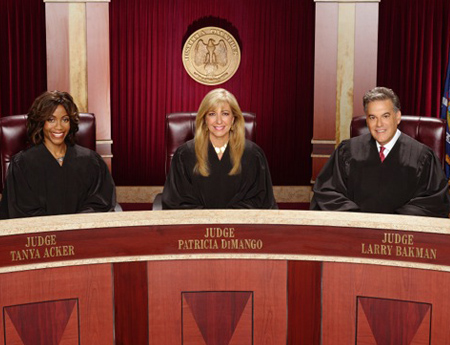Hoping a New Court Format Appeals

On Sept. 15, CBS Television Distribution (CTD) will debut Hot Bench, syndication’s first panel court show and the first to be created and developed by Judge Judy Sheindlin, whose own court show, Judge Judy, is syndication’s top-rated program.
“I think having three judges in daytime creates a fresh dynamic,” says Hilary Estey McLoughlin, CTD president of creative affairs. “It’s the most distinctive thing that’s happened in court shows in the entire time that court shows have been on the air. The panel approach could enliven the court show, much like it’s done for the talk show.”
Sheindlin conceived of Hot Bench when she was visiting Ireland where courtrooms are presided over by a panel of judges instead of just one as they are in the U.S. “Judy’s involvement in the program is really an incentive for viewers to tune in,” says McLoughlin. “That creates a stamp of approval and credibility.”
The judges Sheindlin hired to star in the show—Tanya Acker, Larry Bakman and Patricia DiMango—each come from different backgrounds, but have in common strong personalities and points of view. They don’t have to come to unanimous decisions on cases, but majority rules. And what they decide sticks: The cases are considered binding arbitration and cannot be appealed.
“Judy emphasized that she wanted a team,” says Acker, a Yale Law School graduate and Los Angeles attorney, who starts the questioning on every case. “She wanted three smart, strong personalities who could hash it out, make good decisions and come at things from very different perspectives.
Acker also serves as a sort of moderator, keeping litigants on track when they invariably wander afield. “When these litigants show up, they are hot under the collar. They have 10,000 things they want to talk about. They come in with various axes to grind,” she says. “We impose structure while preserving spontaneity.”
All three judges come in with a great deal of real-world legal experience and Sheindlin views that as an asset. “There’s really just one rule and that rule came from Judy,” says Bakman, a Los Angeles-based criminal defense attorney. “She said: ‘Be true to yourselves.’ For this to be a success, we need to be real, be true and render the verdict in the way we see and feel it.”
Broadcasting & Cable Newsletter
The smarter way to stay on top of broadcasting and cable industry. Sign up below
Each show features a plaintiff and a defendant, who bring their case, of the variety you might find in small-claims court, to the panel. The black-robed judges hear both sides—in what might be a rental dispute or a romantic quarrel that’s resulted in a financial disagreement— on a set that’s situated right next door to Judy’s. Once they’ve heard both side’s stories to their satisfaction, the judges retreat to an on-stage antechamber to discuss their pending decision. The viewers get to see that discussion, which is another factor that CTD hopes will set Hot Bench apart.

“When we go to the back to discuss, we might be on the fence,” says Judge DiMango, who was a justice of the Supreme Court in Kings County, New York. “But we are open to hearing each other’s points of view. We’ve really been able to have an exchange of ideas that I think has been beneficial.”
Hot Bench’s timing could work in its favor: it arrives on the court scene when the genre is ebbing. Last year, CTD’s second-ranked court show, Judge Joe Brown, ended its run after CTD couldn’t come to financial terms with its star. After this season, Twentieth’s Judge Alex will depart, leaving seven court shows in national syndication, including another new court show, Trifecta’s Judge Faith, and excluding Entertainment Studios’ batch of courtroom series, which are sold to stations as a block.
In most of its markets, the half-hour strip will be double-run back to back. Hot Bench is cleared in 98% of the country.
Contributing editor Paige Albiniak has been covering the business of television for more than 25 years. She is a longtime contributor to Next TV, Broadcasting + Cable and Multichannel News. She concurrently serves as editorial director for The Global Entertainment Marketing Academy of Arts & Sciences (G.E.M.A.). She has written for such publications as TVNewsCheck, The New York Post, Variety, CBS Watch and more. Albiniak was B+C’s Los Angeles bureau chief from September 2002 to 2004, and an associate editor covering Congress and lobbying for the magazine in Washington, D.C., from January 1997 - September 2002.










